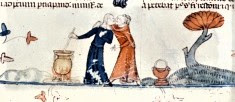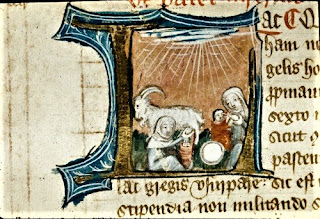Yes, it seems impossible that already in 2015, it's time to greet the month of April. We may still be huddling in inclement weather but we know, just as the medievals did, that Spring is on its way and with it the chance for children to play outdoors during the long evenings. What's less well known is that many of the games still played today by young and old alike have their origins in medieval times.
 |
| Medieval Zodiac |
Hide and Seek
This game first appears in records around 1042. It was originally called "Hyde and Squeak" and involved getting a cow (the "hyde") to sit on a mouse and make it squeak. Pest control was a major issue for medieval people, and it is thought that the game was introduced to alleviate the relentless tedium. Pictorial records exist that clearly reflect the fun that could be had. Some people were less good at following the rules, such as the early twelfth century painters, Hildebert and Everwin.
_writing.jpg) |
| Hildebert and Everwin with Mouse (and Lion) |
Here we see Hildebert merely cursing the mouse and has his lectern balanced on a lion. That is a different game, and has fallen out of favour, especially in Las Vegas.
Tic-tac-toe
These days an easy game that can be played anywhere. Its medieval origins were more demanding. Players had to each collect a "
Ticke, a Tacke and a Toe". For most, the Tick and the Tack were straightforward: people had any number of bodily parasites and it was easy enough to find a nail. The Toe was also easy to acquire as most people had at least one.
.png) |
| Not-so-welcome visitor- the Tick |
But as a game to pass the long winter nights, it tended to be good for only about five minutes. In the late 1300s, we see the Toe rule changing to mean
"the toe of another." The chroniclers report a huge surge in popularity but for the very ticklish, it brought nothing but misery. One abbot in Munich refused to go to sleep for three months for fear of having his digits grabbed.
Follow the Leader
It is interesting that this game was first popularized by medieval kings. The game started with someone at the head of the line. Anyone who didn't follow the action of the leader was out of the game, in a slain-in-battle sort of way. The last person standing was the new leader. Some uncles liked to play this game with their nephews but there are no records of what the nephews thought of it.
 |
| Uncle Richard III |
Catch!
The medieval version of this game was very different to what we play today. It involved scanning your friends and neighbours for any suspicious eruptions. At the first sight of a boil or pustule, you ran away, screaming
"I'm not flipping catching that!" It is a game that has prompted much debate amongst historical fiction writers and some real historians. Central to the controversy is the precise date of the game's origins. There are those who have evidence for February 11th 1406, a claim vociferously challenged by the February 12th 1406 Society. There was an ugly scene at a recent Historical Novel Society Conference where the issue was debated by a panel and a plastic cup of water was spilled. The organisers of the upcoming HNS Denver 2015 conference have decided to cancel their related panel as a precaution.
 |
| Good call, HNS! |
Rock, Paper, Scissors
A game which has evolved over time. In the general absence/rarity of paper or scissors, it was just called "Rock". Players pelted each other with rocks until one person fell down. Or ran away. It is a topic in history that continues to fascinate. The most recent edition of
Exciting Archaeology reported on a find from a garden in the north-west of England that bears an uncanny resemblance to a description from a text from 1308:
“A nyse whyte one, of goodly size, that fittes in the hand and has mosse on that it does not slippe.”
 |
| © Exciting Archaeology 2015 |
Monopoly
We may think of it as modern, but Monopoly is a corruption of the early medieval game of
"Mon au poly." The name can be translated from the Old French as Mine of Many, or the Old English Kiddersham dialect, meaning "The Whole Boiling Lot." Again, it was mostly played by kings. Henry II and his sons, Richard and John, were keen players, especially at Christmas.
.jpg) |
Henry II with sons Richard & (cheat) John
© 2015 E.M. Powell |
Henry and Richard were extremely skilled, but there are accounts that John frequently stole from the bank and had a tendency to tip the board over when he was losing.
Game of Thrones
Our last game, which, ironically, is often mistakenly believed to have medieval origins. But it doesn’t. Honest.
 |
This one belongs to George.
I wouldn't, if I were you. |
References:
Exciting Archaeology, Volume III, February 2015
Facebook: THE REAL MEDIEVAL HISTORY PAGE- YOU’LL NEVER BELIEVE WHAT HAPPENS NEXT!!!!!!!
Fun With Leeches: A Dorling Kinderegg Rough Picture Guide
Martin, George R. R.: A Game of Thrones (A Song of Ice and Fire, Book 1), Bantam; Reprint ed.(2011)
Oxen Droppings and Other Related Signs, 1233-34: Oxford University Press
Powell, E.M.: King John: Tyrannical Rex: Bandwagon Press (2015)
Powell, E.M.: King John: Good With Kittens and Liked Rainbows: Bandwagon Press (2015)
Powell, E.M: Kitten Slaughter- the making of King John: Bandwagon Press (2015)
Starkey, David: History: A Catholic Conspiracy.(Various eds.)
All images Public Domain unless otherwise stated. I wrote this post for the
English Historical Fiction Authors blog.
Please note: the information in this post is only ever valid on April 1st. Except the part about King John cheating at Monopoly. That is historical FACT. Thank you.














_writing.jpg)
.png)



.jpg)
